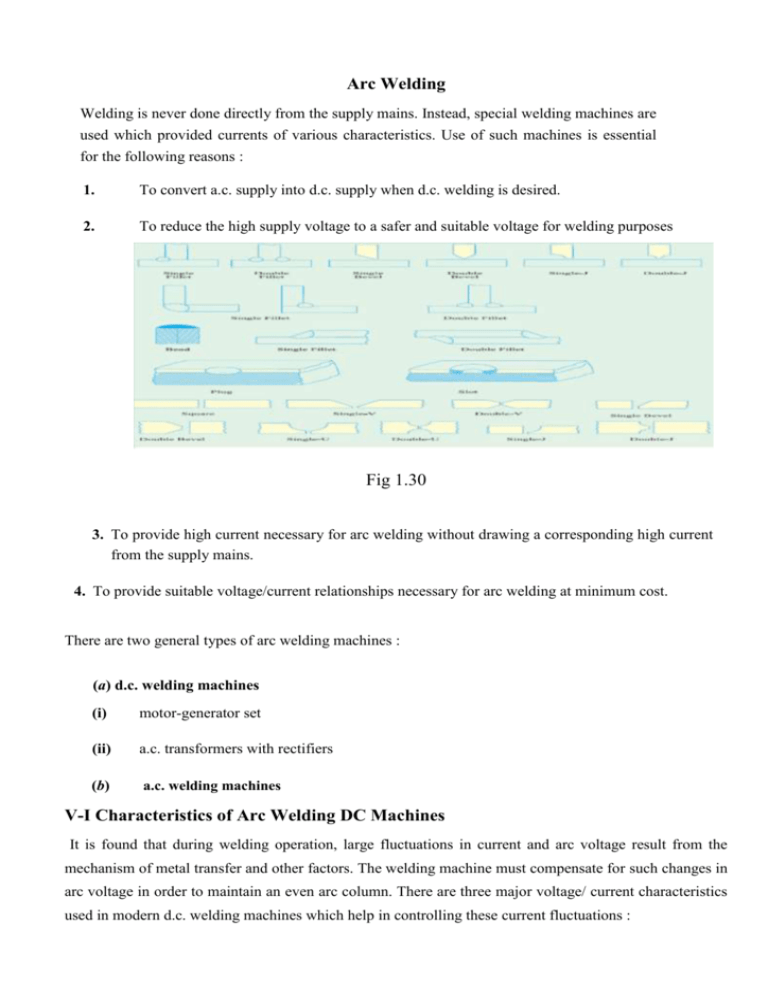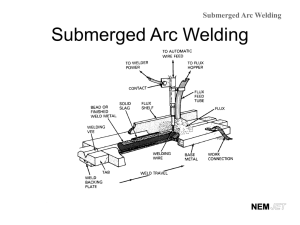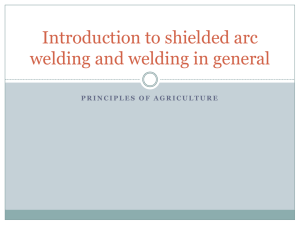variations arc
advertisement

Arc Welding Welding is never done directly from the supply mains. Instead, special welding machines are used which provided currents of various characteristics. Use of such machines is essential for the following reasons : 1. To convert a.c. supply into d.c. supply when d.c. welding is desired. 2. To reduce the high supply voltage to a safer and suitable voltage for welding purposes Fig 1.30 3. To provide high current necessary for arc welding without drawing a corresponding high current from the supply mains. 4. To provide suitable voltage/current relationships necessary for arc welding at minimum cost. There are two general types of arc welding machines : (a) d.c. welding machines (i) motor-generator set (ii) a.c. transformers with rectifiers (b) a.c. welding machines V-I Characteristics of Arc Welding DC Machines It is found that during welding operation, large fluctuations in current and arc voltage result from the mechanism of metal transfer and other factors. The welding machine must compensate for such changes in arc voltage in order to maintain an even arc column. There are three major voltage/ current characteristics used in modern d.c. welding machines which help in controlling these current fluctuations : 1. drooping arc voltage (DAV). 2. constant arc voltage (CAV). 3. rising arc voltage (RAV). Fig 1.31 The machines with DAV characteristics have high open-circuit voltage which drops to a minimum when arc column is started. The value of current rises rapidly as shown in Fig. 1.31(a).This type of characteristic is preferred for manual shield metal arc welding. The CAV characteristic shown in Fig. 1.31 (b) is suitable for semi-automatic or automatic welding processes because voltage remains constant irrespective of the amount of current drawn. Because of its rising voltage characteristic, RAV has an advantage over CAV because it maintains a constant arc gap even if short circuit occurs due to metal transfer by the arc. Moreover, it is well adopted to fully automatic process. DC welding machines can be controlled by a simple rheostat in the exciter circuit or by a combination of exciter regulator and series of field taps. Some arc welding are equipped with remotecontrolled current units enabling the operator to vary voltage amperage requirement without leaving the machines. DC Welding Machines with Motor Generator Set Such a welding plant is a self-contained single-operator motor-generator set consisting of a reverse series winding d.c. generator driven by either a d.c. or an a.c. motor (usually 3-phase). The series winding produces a magnetic field which opposes that of the shunt winding. On open-circuit, only shunt field is operative and provides maximum voltage for striking the arc. After the arc has been established, current flows through the series winding and sets up a flux which opposes the flux produced by shunt winding. Due to decreases in the net flux, generator voltage is decreased (Art. 1.33). With the help of shunt regulator, generator voltage and current values can be adjusted to the desired level. Matters are so arranged that despite changes in arc voltage due to variations in arc length, current remains practically constant. Fig. 1.32 shows the circuit of a d.c. motor-generator type of welding machine. Advantages. Such a d.c. welder has the following advantages : 1. It permits portable operation. 2. It can be used with either straight or reverse polarity. 3. It can be employed on nearly all ferrous and non-ferrous materials. 4. It can use a large variety of stick electrodes. 5. It can be used for all positions of welding. Fig 1.32 Disadvantages 1. It has high initial cost. 2. Its maintenance cost is higher. 3. Machine is quite noisy in operation. 4. It suffers from arc blow AC Welding Machines As shown in Fig. 1.34, it consists of a step-down transformer with a tapped secondary having an adjustable reactor in series with it for obtaining drooping V/I characteristics. The secondary is tapped to give different voltage/ current settings. Advantages. This a.c. welder which can be operated from either a single-phase or 3-phase supply has the following advantages : (i) Low initial cost (ii) Low operation and maintenance cost (iii) Low wear (iv) No arc blow Disadvantages. (i) its polarity cannot be changed (ii) it is not suitable for welding of cast iron and nonferrous metals. Duty Cycle of a Welder The duty cycle of an arc welder is based on a working period of 10 minutes. For example, if a welder is operated for 2 minutes in a period of 10 minutes, then its percentage duty cycle is (2/10) × 100 = 20 percent. Conversely, a 10 percent duty cycle would mean that the welder would be operated for 10 percent of 10 minutes i.e. for one minute only in a period of 10 minutes. Fig1.34 Usually, values of maximum amperage and voltage are indicated along with the duty cycle. It is advisable to adhere to these values. Suppose a welding machine has maximum amperage of 300A and voltage of 50 V for a duty cycle of 60 percent. If this machine is operated at higher settings and for periods longer than 6 minutes, then its internal insulation will deteriorate and cause its early failure







